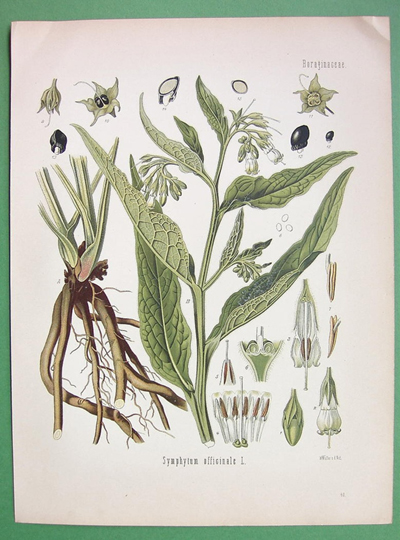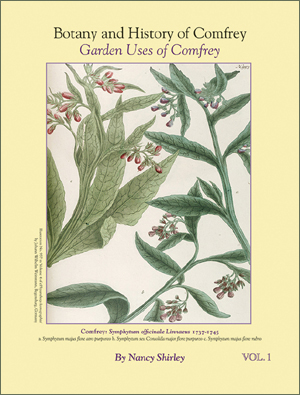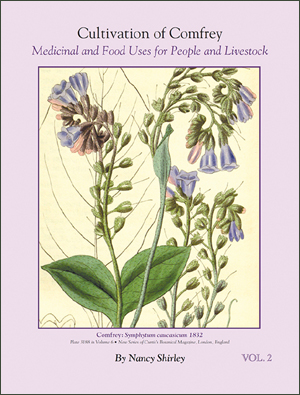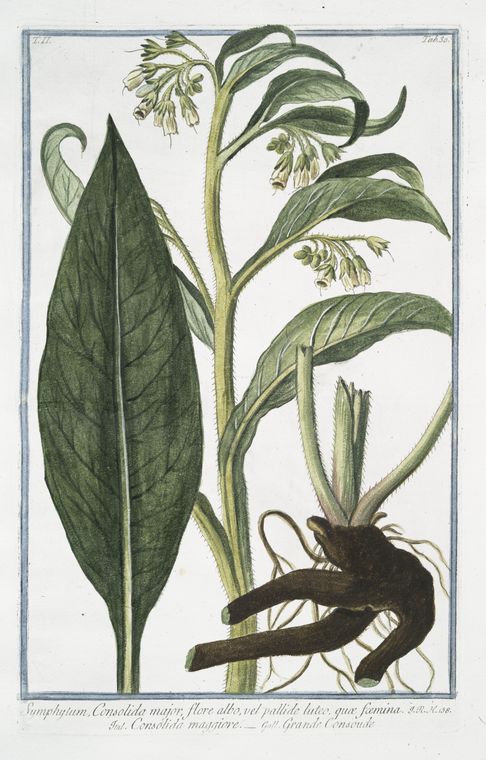Common or True
Comfrey = Symphytum Officinale

-1791--Symphytum%20officinale%20var%20genuinum%20pink-400.GIF)
-1791--Symphytum%20officinale%20var%20genuinum%20yellow-400.GIF)
|
Herbalist's Shop
‘Officinale’ means ‘of the Herbalist’s shop’. ‘Officinale’ means it was the official medicinal plant sold in apothecaries and pharmacopoeias in the middle ages (5th- 15th centuries AD). ‘Officinalis’ or ‘officinale’ are Medieval Latin words that mean a plant was used in medicine and herbalism. The word frequently occurs as the second term of a two-part botanical name.
An apothecary is a medical professional who formulates and dispenses ‘Materia Medica’ to physicians, surgeons, and patients. Today a pharmacist (chemist in Britain) does the same job. Apothecary is also a shop or store where these medicines are sold. ‘Materia Medica’ is the scientific study of medicinal drugs and their sources, preparation, and use.
“The term ‘Officinal’ first came into use in its application to medicines, according to the Oxford Dictionary, in 1693; the Latin Officina being applied to the storeroom of a monastery in which medicines, etc., were kept, and so herbs, plants, drugs, etc., kept in stock in an apothecary’s shop became ‘Officinal’ or as being of recognized utility.”
-The Medicinal Uses of Comfrey by Dr. Charles MacAlister, M.D., F.R.C.P., 1935.
(In Comfrey: Fodder, Food & Remedy, and Comfrey: An Ancient Medicinal Remedy.)
Symphytum
Officinale
Subspecies
and Varieties
The taxonomic ranks: Genus, Subgenus, Section, Subsection, Series, Species, Subspecies, Variety, Subvariety, Form, Subform.
A ‘subspecies’ is a grouping within a species used to describe geographically isolated variants, a category above ‘variety’. It is indicated by the abbreviation ‘subsp.’ in the scientific name.
A ‘variety’ consists of more or less recognizable entities within species that are not genetically isolated from each other, below the level of subspecies. It is indicated by the abbreviation ‘var.’ in the scientific name.
“Three subspecies of Symphytum officinale are recognised by Gadella & Perring (*2000) as subsp. officinale, subsp. bohemicum, and subsp. uliginosum.
S. officinale subsp. uliginosum (A. Kern.) Nyman has not been recorded from the British Isles since before 1930 (**Clement & Foster 1994) although it may occur here (Perring 1994). It is distinguished from the other subspecies by the outer surface of the sepals being more sparsely pubescent and on chromosome number being 2n = 40. It also nearly always has purple buds and flowers (some cytotypes of S. officinale and S. x uplandicum also have purple buds and flowers) and Gadella & Perring (2000) provide further details on its identification.
S. officinale subsp. bohemicum occurs in the Netherlands, and Eastern Europe, particularly in the Czech Republic and Hungary. In the British Isles, it is recorded from only three English vice counties: Cambridgeshire v.c. 29 and Huntingdonshire v.c. 31 (***Stace et al. 2003) and South Lincolnshire v.c. 53 (Perring 1994), with all records being from fens.”
-‘What is Symphytum Officinale Subsp. Bohemicum (Schmidt) Celak: A Taxon on the Red Data Waiting List’ by Clare Coleman O’Reilly, County Durham, England; Botanical Society of Britain and Ireland (BSBI) News, Hertfordshire, England, No. 102, pages 46-48, April 2006.
(* -The European Garden Flora: A Manual for the Identification of Plants Cultivated in Europe, Both Out-of-Doors and Under Glass, 6 Volumes, edited by James Cullen, Sabina G. Knees, and H. Suzanne Cubey. England: Cambridge University Press, 2000. Volume 6: ‘Symphytum’ by T.W.J. Gadella and F.H. Perring, pages 138-141.)
(** -Alien Plants of the British Isles: Provisional Catalogue of Vascular Plants Excluding Grasses by E.J. Clement and M.C. Foster. London, England: Botanical Socieity of Britain and Ireland, 1995.)
(*** -New Flora of the British Isles: Identification of Wild Vascular Plants of the British Isles edited by Clive Stace. Cambridge, England: Cambridge University Press, 2003.)
|

Find out
more about Common Comfrey in chapter 8 of Botany
and History of Comfrey; Garden Uses of Comfrey
Current Botanical Nomenclature
Accepted Names
Symphytum officinale L.
Symphytum officinale subsp. bohemicum (F. W. Schmidt) Celak.
Symphytum officinale subsp. officinale
Symphytum officinale subsp. officinale Sibth.
Symphytum officinale subsp. uliginosum (A.Kern.) Nyman = Symphytum tanaicense Stev.
Not Accepted Names
Symphytum patens Sibth.
Symphytum officinale ssp. uliginosum auct. non (Kern.) Nyman
Symphytum officinale var. officinale L.
|
Common
Comfrey Description
“Comfrey (Symphytum officinale):
Description:
The common great Comfrey hath divers (various) very large and hairy green leaves, lying on the ground, so hairy or prickly, that if they touch any tender part of the hands, face, or body, it will cause it to itch. The stalk that riseth up from among them, being two or three feet (0.6-0.9 meters) high, hollowed, and cornered, as also very hairy, having many suchlike leaves as grow below, but runs less and less up to the top.
At the joints of the stalks it is divided into many branches, with some leaves thereon; and at the ends stand many flowers in order one above another, which are somewhat long and hollow like the finger of a glove, of a pale whitish colour, after which come small black seed.
The roots are great and long, spreading great thick branches under ground, black on the outside and whitish within, short or easy to break, and full of a glutinous (sticky) or clammy juice, of little or no taste.
There is another sort in all things like this, save only it is somewhat less, and beareth flowers of a pale purple colour.
Place: They grow by ditches and water sides, and in divers fields that are moist, for therein they chiefly delight to grow.
Time: They flower in June and July, and give their seed in August.”
-’Culpeper’s English Physician and Complete Herbal to Which are Now First Added Upwards of One Hundred Additional Herbs’ by Nicholas Culpeper, English herbalist, London, England, 1652-1653, pages 131-132.
|

Find out
more about Common Comfrey in Cultivation
of Comfrey: Medicinal and Food Uses for People and Livetstock

|
Common
Comfrey Chromosomes
“The pyrrolizidine alkaloid and triterpene pattern of S. officinale (2n = 24) and S. bohemicum (2n = 24) is identical.
The species S. officinale includes cytotypes with 2n = 24, 40, 48, 54, and 56 chromosomes and is widespread across Europe.
White flowered diploid (2n = 24) populations occur in western, central and eastern Europe. This diploid S. officinale resembles the cream flowered S. bohemicum (2n = 24) from eastern Europe very closely in morphological respect (Murin and Majowski/Majovsky 1982, *Holub 1963).
The 2n = 40 cytotype of S. officinale occurs in the Netherlands and northwest Germany. This type morphologically resembles plants from east Hungary and south Russia. These plants are referred to S. uliginosum Kern. by Soo (1926, 1931) and to S. tanaicense Steven by Degen (1930) and Dobrochaeya (1968) and may have a much wider distribution than S. officinale (2n = 40) from western Europe. Love and Love (1956) and Fernandes and Leitao (1972) report the chromosome number 2n = 40 for plants from Iceland and Portugal, respectively. Love and Love (1975) refer this material to S. uliginosurn (= S. tanaicense). The plants from western and eastern Europe may be identical and belong to the same taxon.
Plants with the higher chromosome numbers (2n = 48, 54, 56) show different distribution patterns. The tetraploids are widely distributed in Europe at lower altitudes. In western and central Europe they are white- or purple-flowered, in eastern Europe purple-flowered.
In south Poland, Czechoslovakia, Yugoslavia, and Bulgaria plants with 56 chromosomes have been found (sometimes plants occur within the same population with 50, 52, 53, and 54 chromosomes). These plants are usually purple flowered. The extra chromosomes are B chromosomes (Hart and Mekki, unpublished).”
-‘Chemotaxonomy of the Symphytum Officinale Agg. (Boraginaceae)’ by Jaarsma, Lohmanns, Gadella and Malingre, Plant Systematics and Evolution, 167, pages 113-127, 1989.
(* -Acta Horti Botanici Pragensis. Praga {Prague}, Czech Republic: Universitas
Carolina, Facultas Rerum Naturalium, 1962-1963. Article: ‘Miscellanea ad
Floram Cechoslovacum Pertinentia’ by J. HoIub, 1-17, pages 47-59.)
|
|



